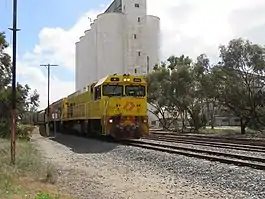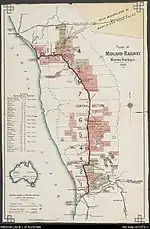Midland railway line, Western Australia
The Midland railway line runs from Midland Junction to Walkaway (30 kilometres south of Geraldton) in Western Australia. Built by the Midland Railway of Western Australia, the 446 kilometre line opened in November 1894.
| Midland railway line | |
|---|---|
 The Westrail P class locomotives Shire of Kulin (2515) and Shire of Dalwallinu (2504) pulling a freight train past the Three Springs grain silos in August 2022 | |
| Overview | |
| Owner | Public Transport Authority |
| Termini | |
| Stations | 39 |
| Service | |
| Operator(s) | Brookfield Rail |
| History | |
| Opened | November 1894 |
| Technical | |
| Line length | 446 kilometres |
| Track gauge | 1,067 mm (3 ft 6 in) |
History

In December 1883, John Waddington representing a syndicate of English capitalists, proposed to Governor Broome to build a line from York via Northam, Newcastle, Bejoording, New Norcia and along the Berkshire Valley to Geraldton under a land grant scheme. A parliamentary select committee recommended the route be altered to branch off from the Eastern Railway at Guildford and run via Chittering, Bindoon, Victoria Plains, Carnamah, Arrino, Upper Irwin and Dongara to Walkaway where it would join the Western Australian Government Railway’s line from Geraldton. The agreement was signed on 27 February 1886, with work commencing a few days later.[1][2]
Under the land grant scheme, 12,000 acres (4,900 ha) of land was granted for every mile of railway completed, a total of 3,319,000 acres (1,343,000 ha). The consortium was able to select land within 40 miles (64 km) of the new railway. Financing problems delayed construction with construction being suspended in June 1887. The Government tried to rescind the contract, but could not as the consortium had until 1890 to complete the first 160 kilometres of the line.[1][2][3][4]
On 21 March 1890, the Midland Railway Company of Western Australia was floated on the London Stock Exchange and Herbert Bond purchased John Waddington's shareholding in the consortium and work recommenced on the 446 kilometre line from both ends.[1]
The first section from Midland Junction to Gingin opened on 9 April 1891, followed by Walkaway to Mingenew on 16 August 1891, Gin Gin to Moore River (Mogumbur) on 22 February 1892, Mingenew to Arrino on 25 February 1892, Mogumbur to Mora on 2 July 1894, with the two sections linked between Carnamah and Three Springs on 1 November 1894.[1][5][6][7]
On 1 August 1964, the line was sold to the Western Australian Government Railways.[6]
Services
The Midland Railway of Western Australia operated a weekly passenger train in each direction. After the sale of the line to the Western Australian Government Railways, it was relaunched as The Midlander. It ceased on 28 July 1975.[8][9]
Today the line is primarily utilised by CBH Group grain trains operating to the ports of Geraldton and Kwinana from eight receival points.[10]
References
- Gunzburg, Adrian (1989). The Midland Railway Company Locomotives of Western Australia. Surrey Hills: Light Railway Research Society of Australia. pp. 7–10, 13, 49, 54. ISBN 0 9093402 77.
- Midland Railway Company Battye Library
- The Midland Railway of Australia Western Mail 3 October 1891
- Royal Commission into the Management, Workings & Control of the Western Australian Government Railways Government of Western Australia December 1947 page 8
- The Midland Railway: Its Jubilee Year The West Australian 31 October 1936
- Affleck, Fred (1978). On Track: The Making of Westrail, 1950–1976. Perth: Westrail. pp. 73–85. ISBN 0724475605. OCLC 6489347.
- Midland Railway Carnamah Historical Society & Museum
- May, Andrew S; Gray, Bill (2006). A History of WAGR Passenger Carriages. Midland, WA: Bill Gray. p. 260. ISBN 0646459023.
- Higham, Geoffrey (2007). Marble Bar to Mandurah: A history of passenger rail services in Western Australia. Bassendean: Rail Heritage WA. pp. 118, 119. ISBN 978 0 9803922 0 3.
- Receival site map CBH Group